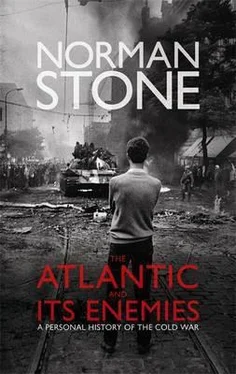Nixon, though supported, electorally, by opponents or at least critics of Johnson’s spending, carried on with and for that matter increased it: when a new chairman of the Federal Reserve System was introduced in July 1970, Nixon said he wanted ‘low interest rates and more money… I have very strong views and… hope that he will independently conclude that my views are the right ones.’ Whether he did or did not, he allowed Nixon to continue the Johnson programmes and to expand them. The result was a rising budget deficit and a rising national debt.
The national debt had reached $271bn in 1946. It fell in proportion to the GNP until 1965 and then boomed. Under Johnson deficit financing became the rule, and in 1968 his Treasury Secretary, Henry Fowler, protested because of the strain for the dollar. A successor, John Connally, dismissed arguments of this sort: the dollar is our currency and it’s their problem. The Great Society programmes were greedy, and by 1975 federal spending had reached $332bn, the deficit being $53.2bn. By then, federal spending had reached almost 25 per cent of gross domestic product (in 1950, it had been 16 per cent). The dollar had a tenfold inflation after 1956. At the time the sixties economists were still confident enough of their ideas and in any case the Western world’s most prosperous elements almost had to support the dollar, and so the deficits marched on and there were regular meetings of international experts to supply funds with which to buy up the excess dollars. Wise heads shook, though they shook in the wrong direction, absurdly conjuring up a ‘liquidity crisis’, and deflation, in which they were quite wrong, because the problem was that there was a glut of money, and an inflation that rocked the entire system. At any rate, tinkering happened. A G10 group of the industrial nations was formed to defend the dollar (and a Basle one for the pound) and they could lend to the IMF, which allowed special drawing rights of immediate credit to defend a currency under threat. The IMF thereby, at last, acquired a role. NATO members were encouraged to spend dollars in the USA and to deposit cash there; American citizens were forbidden to own gold coins (1965) and the GATT round of 1958-62 even allowed countries with threatened currencies to impose an import surcharge of 10 per cent (as happened with the British in 1961 and 1964). American visas were made easier, to encourage tourism in the USA; Germany and Switzerland refused to pay interest on foreign bank holdings (though that was very difficult to arrange and anyway only encouraged countries such as Luxemburg to take them instead). It was all small beer in comparison with the two great problems — the German surplus and US government spending, with a deficit in 1971 of $10bn.
The dollar itself was badly weakened by all of this, and after making constant noises, with suggestions that a form of the old gold standard might be reintroduced, in 1966 de Gaulle stated that the French bank would henceforth want gold instead. This was not just anti — Americanism. At the time, Paris did not much count as a financial centre, so this was easier for France to do than for, say, London, where credit functioned more efficiently (the French banks had been nationalized in 1945). But the pound itself came under constant pressure in the 1960s as speculators based in Switzerland appreciated that it was overvalued, while British spending overseas (partly for military purposes) put it under strain. In the autumn of 1967 there was a threat that the Suez Canal would be closed and therefore unusable for British oil imports. At the existing rate, the British could not exchange harder currencies without seeing their reserves wiped out and the pound was at last devalued, from $2.80 to $2.40. That shifted pressure onto the dollar, and the oil producers sat up.
The Germans also had their reasons for complaint. The Bundesbank had as a primary aim the control of inflation. One cause of that would be an inflow of dollars, swapped for Marks. The exporters liked their undervalued Mark; the savers, as represented by the Bundesbank, their stable currency. The temper of international meetings as to the future became acrimonious and everyone blamed everyone else — Americans, Germans for saving too much; Germans, British and Americans for not saving enough; Swiss, the others for having crooked tax systems; the others, the Swiss, for receiving stolen goods. Japan was now emerging as a large and fast-growing economy, and she like Germany saved: there was not, as in the Anglo-Saxon countries, the sort of consumer boom that sucked in imports. In 1970 there was a brief respite, as the British and Americans balanced their budgets, but the tidal-wave overhang of paper dollars was too great, and was being added to with every breath that Americans took.
Bad news from Vietnam no doubt did not help, but in 1971 a great inflow of dollars into Switzerland, Germany and Holland occurred. The German government decided it would have to float (followed by the Dutch) in order to make Marks more expensive for the speculators. There were rumours that other governments, including even the British, would buy gold at the now giveaway price of $35 per ounce. Fort Knox would be drained dry. What would Nixon do? He retired to Camp David with his advisers and announced, on 15 August 1971, at the end of the weekend, that the dollar’s formal gold link was ended. He even imposed a 10 per cent import charge, and did not even tell the IMF what he was doing. Maybe he did not even know himself. But this was the end of the Bretton Woods system. It was also the end of much else.
One of the bases of Western prosperity after 1947 had been cheap oil. It cost a dollar a barrel in the early fifties and then crept up to two. Transport in the past had been one of the great obstacles to progress, since horses ate 26 pounds of grain every day, and were frequently sick as well as temperamental; wooden wheels needed constant maintenance (hence in all countries ‘Wheeler’, ‘Raeder’, ‘Charron’ is a common surname) and roads were maintained by convict gangs or serf ( corvée ) labour. The internal-combustion engine, using very cheap petrol, was revolutionary, and even before the First World War the cities of the West knew all too well the meaning of ‘traffic jam’. In the 1950s the ownership of cars spread, and, with international competition, they became cheaper. The Volkswagen was the symbol of Germany’s economic recovery, quite soon putting even the great British makers almost out of business. Cheap transport of course allowed manufacturers to drop their costs, at least relative to other goods, and at the same time allowed ordinary consumers to spend on something else the money that they saved on travel. Besides, an automobile industry was very productive of other jobs — maintenance, spare parts, garages, roadside restaurants and hairdressers, and on and on.
The Americans had a very strong hand as regards oil. In the first place, their own reserves were very large. If any effort had been made to put up the world price the Americans would just flood the markets and bring the price down. Then again, oil technology was expensive and very demanding; there was a large investment to be made, and there had to be excellent teamwork, with first-rate management, itself of course expensive, and the Anglo-Americans in that respect were irreplaceable. Just how vital such things were was shown in the 1930s. Mexico had oil; she acquired a revolutionary government that was hostile to the USA. It nationalized oil, offering insultingly low compensation to the American owners. Nationalized oil did not thrive. Men were appointed for political reasons, the state invested in misguided and sometimes corrupt ways, and the labour union was spoiled — too many employees, paid too much. The result was that Mexican oil could not easily compete on the world markets, and the employees (inflation having taken its cull of real value) ended up worse off than they had been before nationalization. The example taught Venezuela (for now), the other great Latin American producer, to behave more prudently: the State, there, took just a fifty-fifty share of the profits. In the Middle East, local rulers were persuaded without much difficulty that they should co-operate with British and American oil firms — in Iran, a nationalist who sought more, Mohammad Mossadegh, was expelled by a coup in which the Shah co-operated with the British and the CIA; Anglo-Iranian thereafter held 40 per cent of the oil, and in Saudi Arabia there were no problems at all, as oil installations spread over the desert, and local rulers who had started off with camels and tents suddenly found themselves rich.
Читать дальше












![Edward Ellis - Adrift on the Pacific - A Boys [sic] Story of the Sea and its Perils](/books/753342/edward-ellis-adrift-on-the-pacific-a-boys-sic-s-thumb.webp)